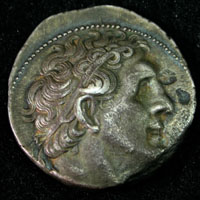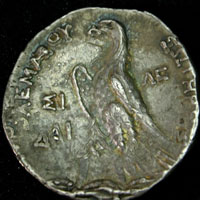Ptolemy II Philadelphos (285-46 BCE), Silver Tetradrachm, Sidon (Lebanon) mint, 250/49 BCE
weight: 13.7g; width: 2.63cm; die axis: 12h


OBV.: Diademed head of Ptolemy I Soter (305-285 BCE) in dotted border; two bankers' marks in right field (flying bird and Taueret, the Egyptian goddess of childbirth).
REV.: In dotted border, eagle with closed wings standing on a fulmen (thunderbolt); overstruck on similar die. Inscribed (PT)OLEMAIOU SWTHROS (= Ptolemaiou Soteros, "of Ptolemy the Savior"). Mint-marks in left field: SI (=Sidon) and DI; date in right field: LC (year 36 = 250 BCE).
HFMA nr. 2006.010.003. Ref.: BMC Ptolemies p.30 nr. 75; Svoronos 749.
The reign of the second Ptolemy (285-246 BCE) was a period of unequaled power and prosperity for the Ptolemaic kingdom. It comprised not only Egypt, but also Cyrene, Cyprus, Palestine, the coast of Asia Minor, and parts of the Aegean sea. After his general had successfully repelled the initial attacks of other diadoch kingdoms, Ptolemy could concentrate on making Alexandria the cultural capital of the world, aiming to increase the holdings of its famous library to 500,000 book rolls.
Ptolemy II was the first Ptolemy who went completely native in the sense that he not only assumed the title of Pharaoh, but also adopted the custom of his Egyptian predecessors and married his sister, Arsinoe II, after his first wife and the mother of his three children, Arsinoe I, had been accused of plotting against him. This incestual marriage, which Ptolemy immortalized on his coins, earned him later the nickname Philadelphos, "Sibling-Lover".
During his early reign, Ptolemy II continued to mint coins with the portrait of his late father. Ptolemy I (305-285 BCE) was the first successor of Alexander that had dared to portray himself on his coins, his hair bound with the Hellenistic symbol for kingship, the royal diadem. Ptolemy II's coins also proclaimed his deified father as Soter ("Savior"), a title the grateful Rhodians had bestowed on him in 305 BCE for delivering them from a siege.
The reverse, standard for all Ptolemaic coins, shows an eagle of Zeus holding Zeus' thunderbolt. Just like the thunderbolts on other coins, the eagle here symbolizes kingship. In addition, it may also have reminded Ptolemy's subjects of the most well-known Egyptian sanctuary to Zeus, the oracle of Zeus Ammon in the oasis of Siwa.
O.K.
Literature:
Mørkholm, Otto, Early Hellenistic Coinage from the Accession of Alexander to the Peace of Apamea (336-188 B.C.), Cambridge 1991.
Svoronos, J. N., Ta Nomismata tou Kratous ton Polemaion, vol. 2, Athens 1904, translated by Catherine Lorber.
Svoronos, J. N., Ta Nomismata tou Kratous ton Polemaion, vol. 2, Athens 1904, translated by Catherine Lorber.

